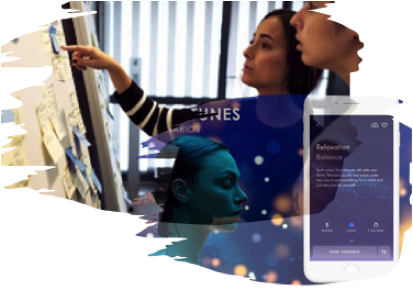Case Study: Agile IP design for digital use cases at Hansgrohe RainTunes
In the current fast changing world traditional approaches of long term strategic research and development processes might not fit the promptness of change currently taking place. The knowledge-driven economy in front of businesses now sets new challenges that can be summarized in the following: the markets have become global and with new competitors; life cycles of products and services are rapidly shrinking; users are increasingly demanding; The complexity of technology is increasing. In such an economy, changes have become almost daily business, which makes the entire business environment permanently changing. So, the key question that is being posed today to all companies, regardless of their size, is how to survive under such conditions.
As a result, more and more companies focus on capabilities of their employees and organizations to launch agile new products, re-design the core processes, business models and IP management of the company. Especially bigger mature companies face the challenge of transforming into this new area of IP management. New structures and frameworks help these companies to transform into an innovation driven enterprise.
The term Agile Innovation can take several forms: Agile Process Management, Agile Management, Agile Product Management, Agile Development. The term “agile”means “fast and well-coordinated on the move; and originates from Latin agilis, which means “it has speed in motion, turning, clever, smart”. If the term is applied to innovative systems, it refers to the Agile Innovation System. The generic definition on Wikipedia is:
“Agile innovation refers to an iterative, incremental method of managing the design and build activities of engineering, information technology and other business areas that aim to provide new product or service development in a highly flexible and interactive manner.”
Agile innovation is a specific guide in the field of designing and implementing effective innovation strategies by strengthening the classical methodology of innovation with the Agile process. In order to facilitate Agile collaborative processes, self-organized and self-optimizing teams can be formed in the organization to better solve complex problems and create disruptive innovations. In this sense, three key functions of Agile innovation are:
- Achieve maximum speed in innovative efforts. Agile innovations support the effective development of created ideas and their productive implementation, through a common innovation, from leadership to operation.
- Risk reduction. Agile innovation encourages the creation of a culture of innovation, and through increased collaboration between all actors in innovation, risk can be reduced.
- Engaging the entire organization in creating and developing the best ideas, since agile innovation promotes the principles of integration. Effective innovation, as a rule, does not happen by chance, but it is the result of the deliberate design and improvement of the organization’s innovation.
Design thinking and IP design within the RainTunes project at Hansgrohe
The starting point was Roberto Verganti’s assumption that customers do not buy objects but meaning. Design-driven innovation means radical shifts in meaning. For a clearer understanding of such shifts in meaning, take the smartphone, for example. While cell phones were originally developed for wire-less voice communication, today’s smartphones are universal personal assistants and life companions. Cars, too, are going to undergo a shift in meaning through electric and autonomous driving – perhaps as a place for good conversations or intense family experiences. Design-driven innovation is about gaining the authority to interpret meanings for people. It is not just about how people use things and people’s needs, but also about how people interpret and see things and what they mean to them.
Hansgrohe is positioned as a premium brand: “We are world leaders in creating pleasurable, life-enhancing experiences with water; our broad portfolio of products is focused on faucets and showers for bathrooms and kitchens, aimed at quality-conscious customers in the middle and upper market segment. The brand Hansgrohe comes with the slogan: “Meet the beauty of water”:
Cannot open the video? Please click: https://youtu.be/HJ4pO9Ajh8M
The starting point of Hansgrohe’s digitalization project was therefore to find out what showering means to people. An online survey was used to capture people’s impressions and interpretations. Respondents included women and men between the ages of 30 and 70, with a single household income of at least €2,000 and a two-person household income of at least €4,000 as well as different family situations and living in their own homes or in rented flats. The question was: How do people really shower?
The analysis led to the development of different archetypes such as indulgence showerers, grooming showerers, quick showerers and hotel showerers. The analyses also revealed that people feel that their lives are constantly accelerating. An increasing number of people feel left behind by digitalization. They feel pressured by their everyday lives and their personal needs. People have less and less time for a growing number of things. The hunger for more is almost insatiable. As a result, they are feeling an ever-increasing need for retreat, well-being, recreation and leisure. Paradoxically, this leads to additional stress. Hansgrohe wants to play its part in breaking this vicious circle.
The shower is becoming a place of retreat where people can recharge their batteries, daydream, enjoy some me-time and focus on their worries, problems, fears and dreams. Showering is less and less about personal hygiene. The analysis showed that people tend to use showers as an occasion-specific ritual. The shower is a place of retreat where we can escape from the hustle and bustle of every-day life for a short but intense period of time, a place where we can deal with everyday problems which are too small for seeking professional help but too important to ignore. The Rain tunes system offers the users multisensoric shower scenarios providing an individual showering experience. These scenarios include individual sound, lighting and fragrance for the best showering experience tailored to the moods and needs of the customer.
Cannot open the video? Please click: https://youtu.be/Iucpxewcnqo
RainTunes offers vitalizing showering experiences that fit people’s lifestyles and offer them a broad spectrum of options for alleviating everyday problems. RainTunes is a cyberphysical product combining hardware and software components. Ultimately, the showering experience is an app that can be taken anywhere the RainTunes eco-system is installed: from private bathrooms to hotels, holiday homes, theme parks and hospitals. Based on the eco-system design, which consists of a digital platform for showering experiences, a number of business models are conceivable.
Cannot open the video? Please click: https://youtu.be/hbkZMgi71jQ
Multiple scenarios and use cases were analysed within the scope of the IP design process. IP design follows the agile method of project management. Agile project management such as design thinking and IP design is fundamentally different from traditional project management. In agile project management, there is a different emphasis on what a project should achieve and how. Not all project evaluation criteria of the traditional paradigm are given equal weight. Agile projects are characterized by a comparatively high tolerance when it comes to typical target variables such as scope, process, time and costs, and by significant client involvement. Agile project methods place a strong focus on deliverables and quality from the user’s perspective.
IP design is an agile method of developing and protecting digital business models by means of digital patents. IP design puts the customer and their product experience at the heart of all activities by asking what the customer “really” wants and how digital transformation can answer this question. IP design is geared towards identifying, evaluating and selecting appropriate methods in iterative steps.
Cannot open the video? Please click: https://youtu.be/7V5p2LaETT4
The RainTunes project allowed Hansgrohe to derive key success factors for design thinking and IP design. The pivotal role of the project partners in the progress of IP design requires highly effective communication. The project-based working methods of IP design are in line with today’s interconnected work environment characterized by flat hierarchies, transparent contributions and solution-oriented thinking. This applies in particular to the agile overall approach involving design thinking methods.
Therefore, a corporate culture is needed that recognizes the creative contributions of the team members and prioritizes the outcome over planning. The methodology itself must also be secondary to the outcome, and to the exclusive character of the business model and the customer experience.
Case Study Tasks and Questions – Group 1
For the present case, provide an analysis of the agile management of Hansgrohe during the development of RainTunes.
Task 1:
Please explain the ideas of design driven innovation and how the change of technology and meaning drives innovation. Please explain what design driven innovation means for innovation in the showering business in the context of the RainTunes project.
Task 2:
Please explain what the design thinking approach is and how it was implemented in the design process of RainTunes.
Task 3:
There are different styles of project management to finish projects efficiently. Please describe the traditional project management and the waterfall approach. Identify the strengths and weaknesses of this approach.
Task 4:
Please describe the agile project management and identify its strengths and weaknesses.
Task 5:
Please explain the basic approach of IP-Design used to develop RainTunes. Please explain why IP-Design is an agile method.
Here is the solution of group 1:
Cannot open the video? Please click: https://youtu.be/zsyuQvdlidw
Case Study Tasks and Questions – Group 2
For the present case study provide an analysis of the leadership concepts used in the development of RainTunes by hansgrohe.
Task 1:
The showering business changes like other businesses from traditional business to digital business. Hansgrohe are now also selling digital showering experiences, not only showerheads and fittings. Please explain why the digital transformation is not a trend, but a revolution and how it forces industries to design their products in a different way.
Task 2:
To solve the new complexities of the digital revolution a plannable procedure is needed by company leaders. Please explain shortly why IP-design is a leadership tool and what are its general features as a leadership tool. Please explain the main leadership tasks and how they are implemented with the core elements of IP-design.
Task 3:
Please explain the 5 concepts of digital leadership and show how they are represented in the IP-design process used in the RainTunes project.
Task 4:
The organization of a company and the organization of work within a company is a main topic of leadership. Please explain the different organizational structures in a company. Please explain what makes project teams different from the other organizational structures.
Task 5:
Please explain how a project team in the development process for RainTunes looked like. Which groups of people are involved and what are their roles in the IP-design process?
Here is the solution of group 2:
Cannot open the video? Please click: https://youtu.be/GjATRDpnJjE
Case Study Tasks and Questions – Group 3
For the present case study please perform an IP design procedure to identify potential invention environments for the digital showering experience.
Task 1:
Please explain which customer benefits / added value the digital shower experience provides to the user.
Task 2:
Please describe the process of using or generating the digital showering experience. For this purpose, please perform a so-called cognitive walkthrough.
Task 3:
Please assign the customer benefits to the corresponding process steps in the cognitive walkthrough. In other words, please show in which process steps the customer benefits are generated.
Please show by means of prioritization which process steps in the cognitive walkthrough are the most important for the generation of these customer benefits.
Task 4:
Please collect exemplary system components (both digital and physical) that are necessary for the execution of the process step “adapt selected showering scenario”.
Task 5:
Please bring the system components into a structure that allows for describing the basic functional relationships between these components.
Task 6:
Please describe the given patent type in a nutshell. Then map the functional relationship between the system components described in this patent type to the structure created above.
Task 7:
Now use the structure to identify further non-trivial functional relationships between the system components around which IP can be designed. Above all, focus on the questions:
- Which system components can be added or omitted compared to the patent type, and which functional relationships arise from this?
- How can the functional relationships be meaningfully modified?
Here is the solution of group 3:
Cannot open the video? Please click: https://youtu.be/9cDM6Bbv4Pc



